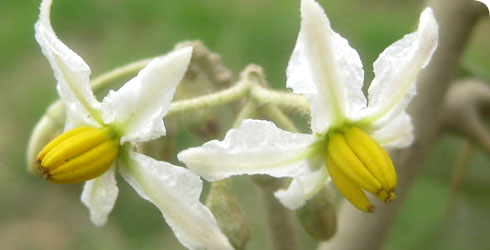Taxonomy
Morphology
- Solanum aculeastrum is an erect shrub or a small tree, 1-6m tall.
- It has prominent orange or orange-brown flat prickles shaped like hooks, 0.8-1.7cm long.
- The whole plant is covered in small star-shaped hairs 0.5-1.0mm in diameter with 8-12 side rays.
- Each star-shaped hair is on a small stalk. On the young stems the stalks on some these hairs become longer and thicker until they grow into prickles.
- Solanum aculeastrum is easy to recognize by its lobed leaves 8-15cm long which are white-grey underneath.
The flowers
- The flowers are white or rarely pale purple, 1.5-3.2cm in diameter, with deep incisions between each petal.
- Anthers 4.5-6.5 mm long and poricidal at the tips.
- Solanum aculeastrum encompasses wide variation in flower morphology: some flowers open fully, with a deeply stellate corolla and long thin pale yellow lobes like those of S. zanzibarense, whereas others have flowers remaining partly closed, with short broad corolla lobes.
The fruit
- Fruit is a bright yellow, globose, ellipsoid, or pyriform berry, 3-5cm in diameter. It is frequently compared to lemons, often apiculate or elongated, with a tendency to develop warts. Warty fruits are most common in Uganda in northern Democratic Republic of the Congo, but also occur sporadically in South African populations.
- There are around 50-100 seeds in every berry, they are 4-5mm long and flat, shaped a bit like a kidney.
Diagnostic description
Solanum aculeastrum is a widespread and variable species found across African highlands, easy to recognise by its discolorous lobed leaves that are almost white below and by its prominent orange downwardly hooked prickles.
-

Lookalikes
Solanum aculeastrum is a species unlikely to be misidentified. Find out what distinguishes it from other species in its range.
-

Evolution
Find out where Solanum aculeastrum originated from and what recent research has suggested about its evolution.
